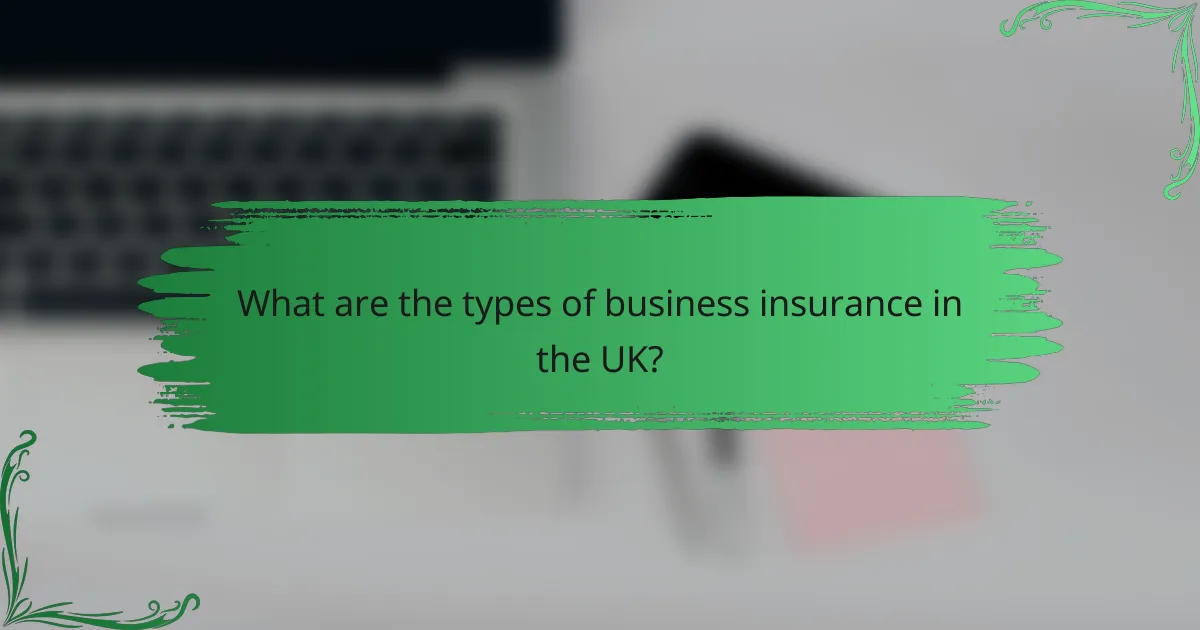In the UK, businesses need various types of insurance to mitigate risks and ensure smooth operations. Key categories include liability coverage, which protects against legal claims; property protection, safeguarding physical assets; and employee benefits, which enhance workforce welfare. Each type plays a crucial role in maintaining financial stability and resilience in the face of unforeseen challenges.

What are the types of business insurance in the UK?
In the UK, businesses typically require several types of insurance to protect against various risks. The main categories include liability coverage, property protection, and employee benefits, each serving distinct purposes to safeguard business operations and assets.
Liability coverage
Liability coverage protects businesses from claims resulting from injuries and damage to other people or property. This type of insurance is crucial for mitigating financial risks associated with lawsuits or legal claims.
Common forms of liability coverage include public liability insurance, which covers injuries to third parties on your premises, and employers’ liability insurance, which is mandatory for most businesses with employees. It’s advisable to assess your specific risks to determine the appropriate level of coverage.
Property protection
Property protection insurance safeguards a business’s physical assets, including buildings, equipment, and inventory, against risks like theft, fire, or natural disasters. This insurance is vital for maintaining operational continuity after unexpected events.
Businesses should consider the value of their assets and the potential risks they face when selecting property protection. Policies can vary significantly, so comparing options and understanding coverage limits is essential to ensure adequate protection.
Employee benefits
Employee benefits insurance includes various policies that provide financial support to employees in case of illness, injury, or other unforeseen circumstances. This type of insurance can enhance employee satisfaction and retention.
Common employee benefits include health insurance, life insurance, and disability coverage. Businesses should evaluate their workforce’s needs and industry standards to create a competitive benefits package that attracts and retains talent while complying with legal requirements.

How does liability coverage protect businesses?
Liability coverage protects businesses by providing financial support in case of legal claims or lawsuits arising from injuries or damages caused by the business’s operations. This type of insurance helps cover legal fees, settlements, and judgments, allowing businesses to operate with reduced financial risk.
General liability insurance
General liability insurance is essential for most businesses, as it covers claims related to bodily injury, property damage, and personal injury. For instance, if a customer slips and falls on your premises, this insurance can help pay for their medical expenses and any legal costs associated with the claim.
When selecting general liability coverage, consider factors such as the size of your business, the industry you operate in, and the level of risk involved. Premiums can vary widely, often ranging from a few hundred to several thousand dollars annually, depending on these factors.
Professional indemnity insurance
Professional indemnity insurance, also known as errors and omissions insurance, protects businesses that provide professional services or advice. This coverage is crucial for fields like consulting, legal, or medical services, where clients may seek compensation for perceived negligence or mistakes.
When considering professional indemnity insurance, evaluate the specific risks associated with your profession and the potential financial impact of claims. Coverage limits and premiums can differ significantly, so it’s advisable to compare options and choose a policy that aligns with your business’s needs and budget.

What does property protection insurance cover?
Property protection insurance covers damages to your business property, including buildings, equipment, and inventory. It helps safeguard your assets against risks such as theft, fire, and natural disasters, ensuring your business can recover from unexpected events.
Commercial property insurance
Commercial property insurance provides coverage for physical assets owned by a business. This includes buildings, machinery, and inventory. Policies typically cover damages from events like fire, vandalism, and certain weather-related incidents.
When selecting a commercial property insurance policy, consider the replacement cost versus actual cash value. Replacement cost covers the expense of replacing damaged items without depreciation, while actual cash value accounts for depreciation, which can lead to lower payouts.
It’s crucial to assess the specific risks your business faces based on its location and industry. For example, businesses in flood-prone areas may need additional flood insurance, as standard policies often exclude such coverage.
Business interruption insurance
Business interruption insurance compensates for lost income during periods when your business cannot operate due to a covered event, such as a fire or natural disaster. This type of insurance helps cover ongoing expenses, like rent and salaries, while your business is temporarily closed.
When considering business interruption insurance, evaluate the coverage period and limits. Policies may cover losses for a specific duration, often ranging from a few months to a year, depending on the severity of the interruption.
To ensure adequate protection, calculate your business’s average monthly revenue and ongoing expenses. This will help you determine the appropriate coverage amount to maintain financial stability during recovery. Avoid common pitfalls by reviewing your policy regularly and updating it as your business grows or changes.

How do employee benefits enhance business insurance?
Employee benefits significantly enhance business insurance by providing additional coverage that protects both the employer and employees. These benefits can improve employee satisfaction and retention while also mitigating risks associated with health-related claims and workplace injuries.
Health insurance options
Health insurance options are a critical component of employee benefits that can reduce the financial burden on businesses. By offering comprehensive health plans, companies can attract and retain talent while ensuring employees have access to necessary medical care. Typical plans may include coverage for hospital visits, preventive care, and prescription medications.
Employers should consider various health insurance models, such as Health Maintenance Organizations (HMOs) or Preferred Provider Organizations (PPOs), each with different cost structures and provider networks. It’s essential to evaluate the needs of your workforce and the associated costs, which can range from hundreds to thousands of dollars per employee annually.
Pension schemes
Pension schemes are another vital aspect of employee benefits that contribute to long-term financial security for employees. These plans can include defined benefit pensions or defined contribution plans, such as 401(k)s, where employers may match employee contributions up to a certain percentage.
Implementing a pension scheme not only helps in retaining employees but also provides tax advantages for the business. Employers should assess their financial capacity and regulatory requirements, as contributions can vary widely based on the scheme type and employee participation rates. Offering a competitive pension plan can enhance your business’s reputation and appeal in the job market.

What are the key factors to consider when choosing business insurance?
When selecting business insurance, consider your specific needs based on size, industry, and risk exposure. Tailoring coverage to your unique situation ensures adequate protection against potential liabilities and losses.
Business size and type
The size and type of your business significantly influence your insurance requirements. Small businesses may prioritize general liability and property insurance, while larger enterprises might need more comprehensive coverage, including cyber liability and professional indemnity.
For example, a small retail shop may only need basic property protection, while a tech startup could require specialized coverage for intellectual property and data breaches. Assessing your business structure helps determine the necessary policies.
Industry-specific risks
Different industries face unique risks that should be addressed in your insurance plan. For instance, construction businesses often need coverage for equipment and worker injuries, while healthcare providers must consider malpractice insurance.
Understanding the common hazards in your industry allows you to select appropriate coverage. For example, restaurants may need food liability insurance, while manufacturers might require product liability coverage. Evaluate your sector’s risks to ensure comprehensive protection.

How can businesses in the UK save on insurance costs?
Businesses in the UK can save on insurance costs by implementing strategies such as bundling policies and regularly reviewing their coverage. These approaches help ensure that companies are not overpaying for unnecessary coverage while still maintaining adequate protection.
Bundling policies
Bundling insurance policies involves purchasing multiple types of coverage from the same insurer, which can lead to significant discounts. For example, a business might combine liability, property, and employee benefits insurance under one provider, potentially saving up to 20% on premiums.
When considering bundling, it’s essential to compare the bundled rate against individual policy costs to ensure savings. Additionally, check if the insurer offers tailored packages that meet specific business needs, as this can enhance both coverage and cost-effectiveness.
Regularly reviewing coverage
Regularly reviewing insurance coverage allows businesses to adjust their policies based on changing needs and market conditions. This practice can reveal opportunities to reduce premiums by eliminating unnecessary coverage or adjusting limits to better match current risks.
It’s advisable to conduct a coverage review at least annually or whenever significant changes occur, such as business expansion or shifts in employee numbers. Engaging with an insurance broker can provide insights into market trends and help identify potential savings.

What are the emerging trends in business insurance?
Emerging trends in business insurance reflect the evolving landscape of risks and opportunities. Key areas of focus include digital transformation, which enhances efficiency and customer engagement, and an increased emphasis on cyber liability to protect against growing online threats.
Digital transformation in insurance
Digital transformation in insurance involves adopting technology to streamline processes and improve customer experiences. Insurers are increasingly using data analytics, artificial intelligence, and automation to assess risks and tailor policies, making insurance more accessible and efficient.
For businesses, this means faster claims processing and personalized coverage options. Companies should consider investing in digital tools that enhance their insurance management, such as online policy management systems and mobile apps for claims submission.
Increased focus on cyber liability
As cyber threats become more prevalent, there is a heightened focus on cyber liability insurance. This type of coverage protects businesses from financial losses due to data breaches, ransomware attacks, and other cyber incidents. Companies are urged to evaluate their cyber risk exposure and consider policies that cover potential liabilities.
When selecting cyber liability insurance, businesses should look for coverage that includes data recovery, legal fees, and notification costs. It’s crucial to understand the specific terms and conditions, as coverage can vary significantly between providers. Regularly reviewing and updating cyber insurance policies is advisable to keep pace with evolving threats.



